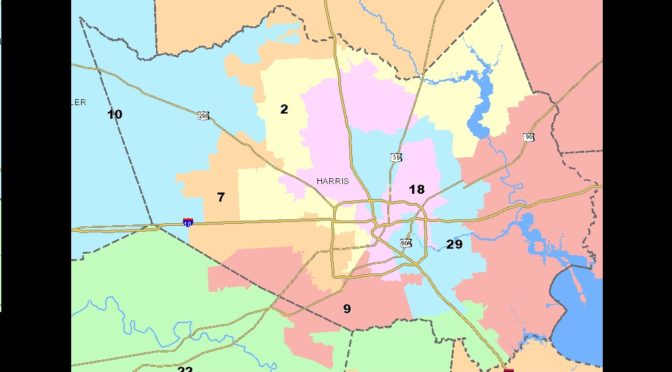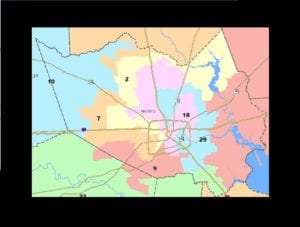You gotta hand it to politicians… if there’s one thing they know how to do, it’s getting reelected. Part of the reason I suppose you could say the same for any politician halfway worth their salt.
Those elections are certainly how Texas perseveres as a reliably “Red State” even as our demographics have shifted so dramatically that many folks are puzzled as to how there are so few competitive races in this Republican dominated state.
But for those that have been paying attention, the answer to that conundrum is clear… illegal redistricting. As James Barragan with the Dallas Morning News reports, one Federal Court is sending state leaders a clear message…
Texas statehouse districts drawn by the Republican-led legislature in 2011 intentionally diluted the votes of minorities, violating the U.S. Constitution and parts of the Voting Rights Act, a federal court ruled Thursday.
In a 2-1 ruling, a three-judge panel in San Antonio found that the maps gave Republicans an advantage in elections and weakened the voting strength of minority voters. House Districts in Dallas and Tarrant counties were among those in which the judges ruled minority voters had seen their clout weakened.
The ruling is yet another blow to the state in its six-year legal battle over the redrawing of the maps. Last month, the same court found that the state’s congressional maps were drawn with intent to discriminate against minority voters and invalidated three congressional districts. And last week, a federal judge ruled that the state’s voter ID law was written with intent to discriminate.
“The evidence of the mapdrawing process supports the conclusion that mapdrawers were motivated in part by an intent to dilute minority voting strength,” U.S. District Judges Xavier Rodriguez and Orlando Garcia wrote in the 171-page ruling. “Discussions among mapdrawers demonstrated a hostility to creating any new minority districts as those were seen to be a loss of Republican seats, despite the massive minority population growth statewide.”
Here is the full court ruling, for those interested.
Redistricting is a very complicated process, but here are the basics. After each Federal Census (every 10 years), the Texas Legislature is required to divide the state by election districts which most closely match the shifts that have occurred.
It’s definitely no secret that the state of Texas grew from 2000 to 2010, as was reflected in the 2010 Census. But what many folks may not know is that growth was overwhelmingly led by one group: the Latino community. Of the 4.2 million residents Texas gained between 2000 and 2010, nearly 2.8 million of them were Latino. That is 65 percent.. a clear majority of population within the state.
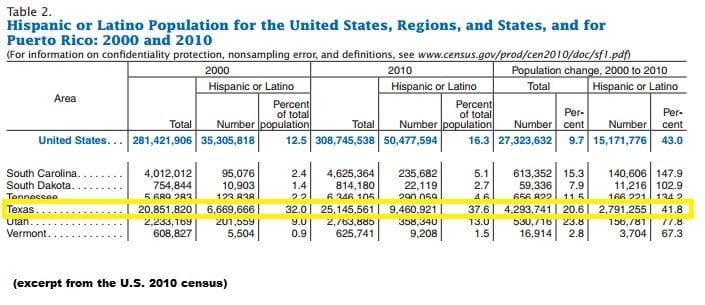
We also know that much of this growth occurred in occurred the state’s largest metropolitan areas. So Texas didn’t just grow in population, it also became more urban and more suburban.
As a result of Texas’ enormous growth, the state was allotted 4 additional seats in the United States House of Representatives, increasing our overall representation in the House to 36 members.
Yet when creating new Congressional Districts, the communities holding the population gains were last in line to be ensured representation. Two ways Texas Republicans used to achieve this dilution? Cracking and Packing.
With Cracking, you dilute an area’s voting power by slicing up its Congressional Representation. Urban residents in Austin certainly share some common concerns in Austin, but they are cracked between 5 different members of Congress.
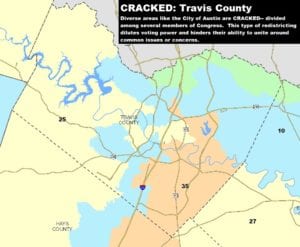
With Packing, you take certain groups and shove them all together in the same district them together in a way which undermines to their voting power. District 35 is a great example of this, where the minority communities of Austin and San Antonio are cracked, then knit together in something of an awkward dumbbell.
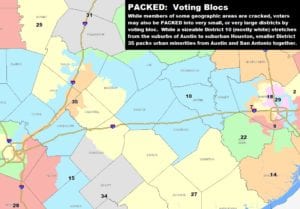
Cracking and packing often work in tandem. As an example, both Austin and San Antonio have sizable Latino populations. But if they’re in different cities, what would they have to do with each other? Under Texas’ redistricting scheme one chunk of the Latino population from San Antonio is packed in with minorities in East Austin, while other district residents are connected by a small sliver along Interstate 35.
It through techniques like Cracking and Packing that Texas Republicans were able to do what is called Gerrymandering… they drew districts which are manipulated to enhance the strength of rural and suburban (mostly) white voters, while undermining the rapidly growing (mostly) minority vote.
In the present political era, it’s tough to tell how such rulings would be enforced by Attorney General Sessions. But whatever accountability may be lacking in the Federal Government, we can take notice and make legislators pay the consequences in 2018 and 2020.
